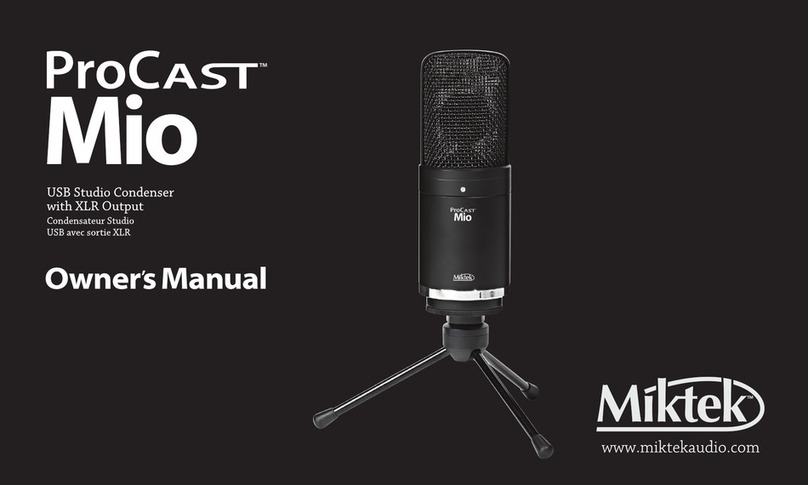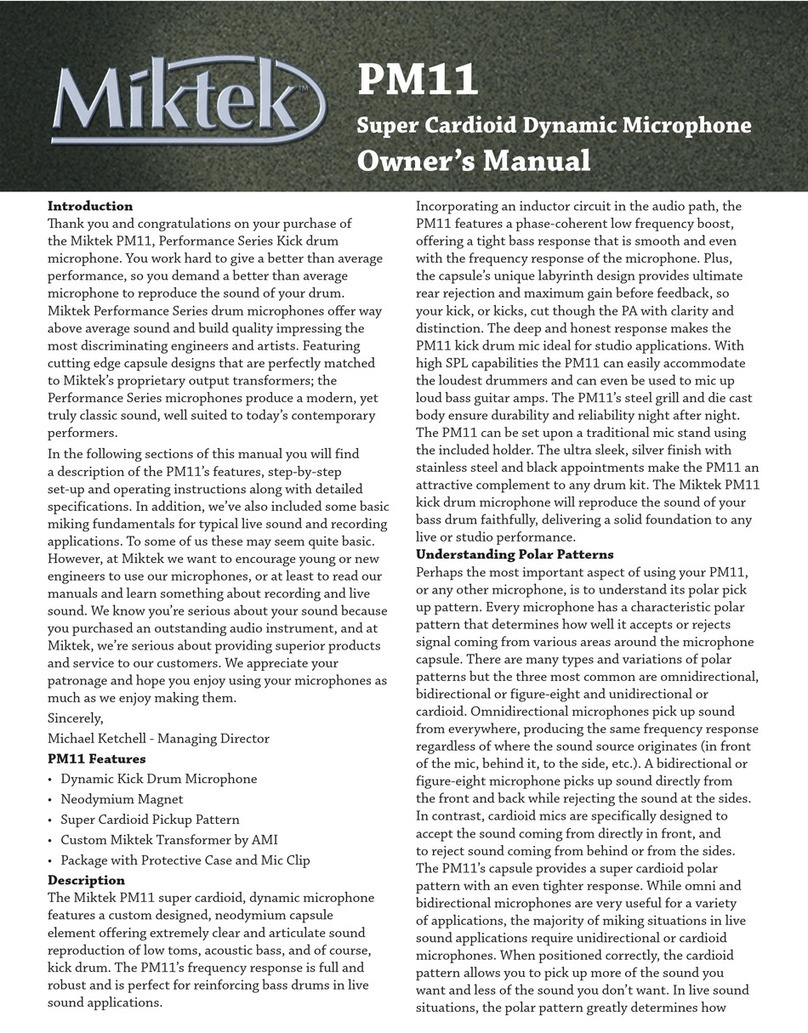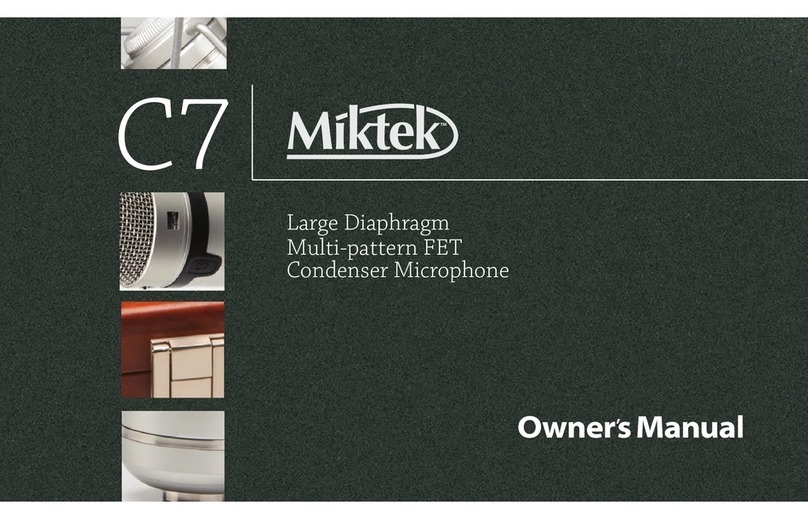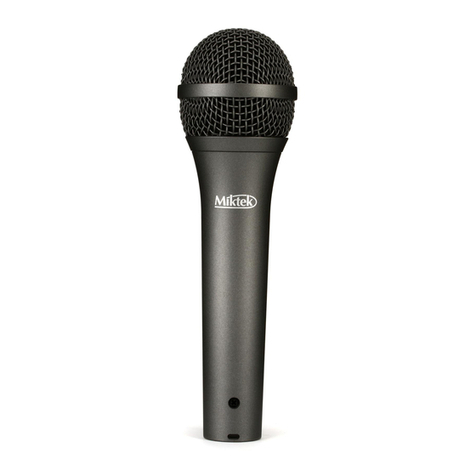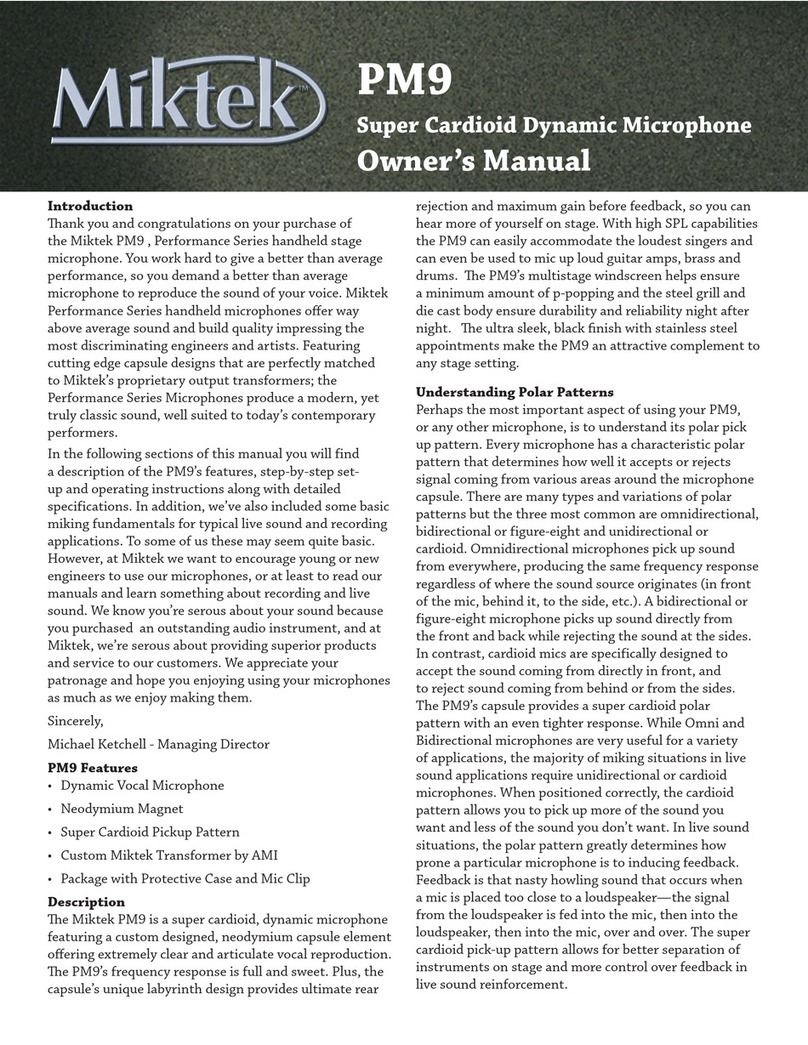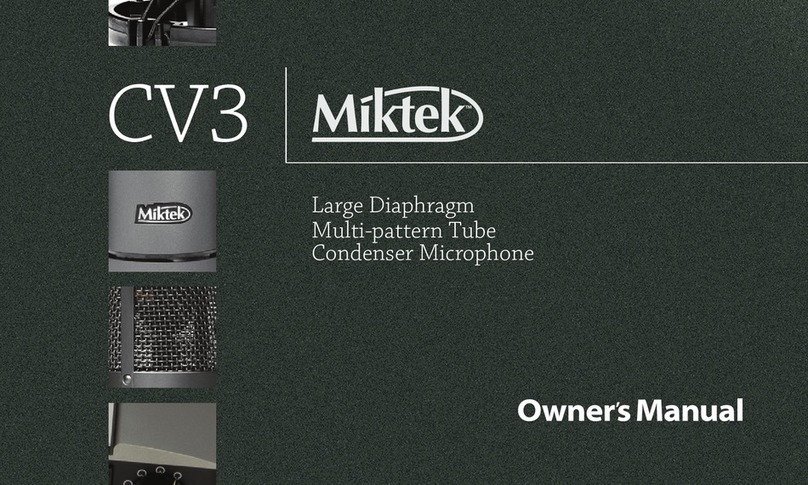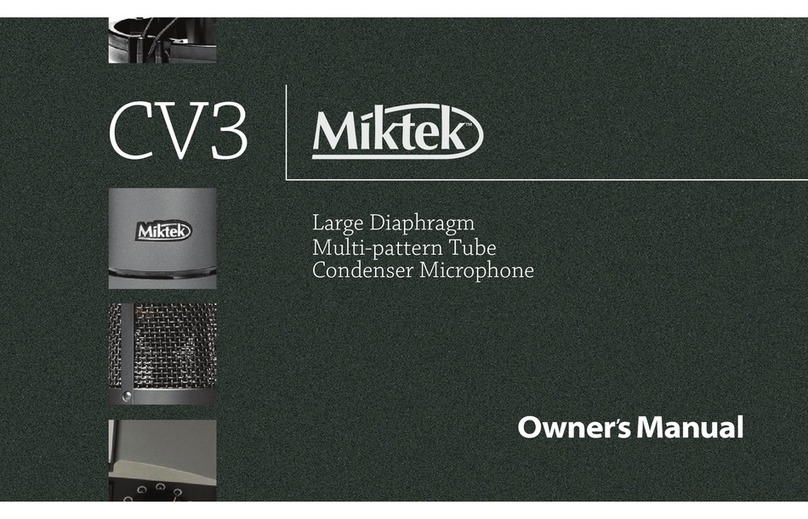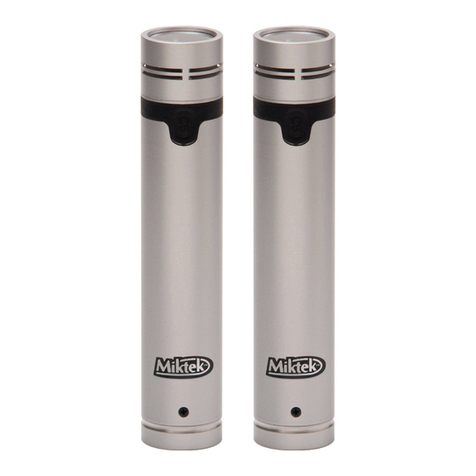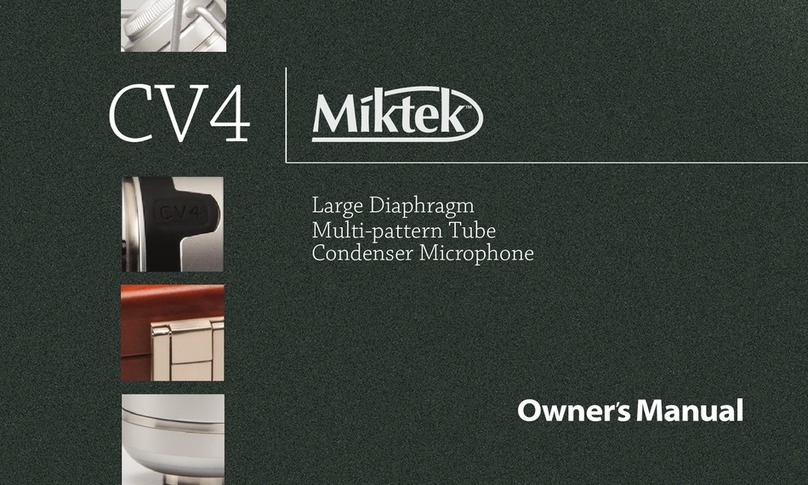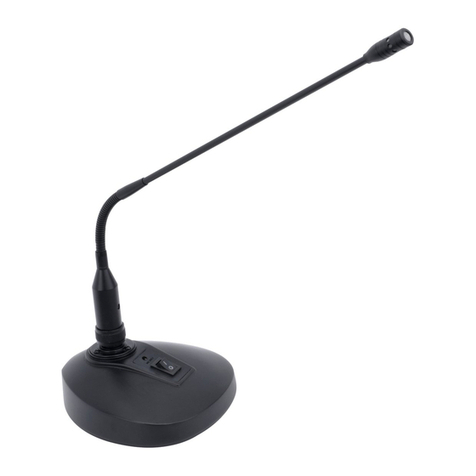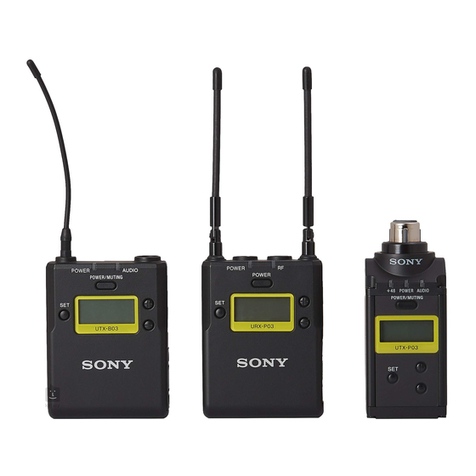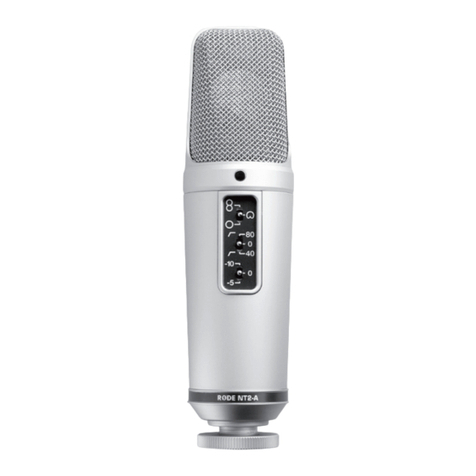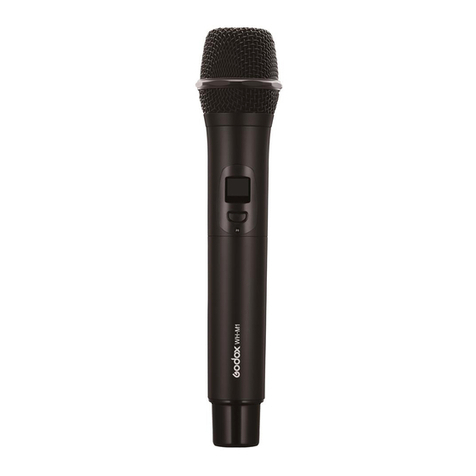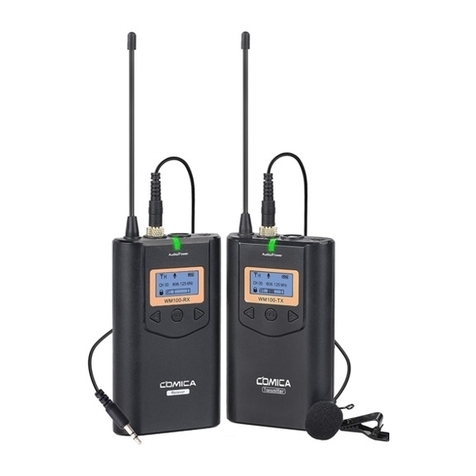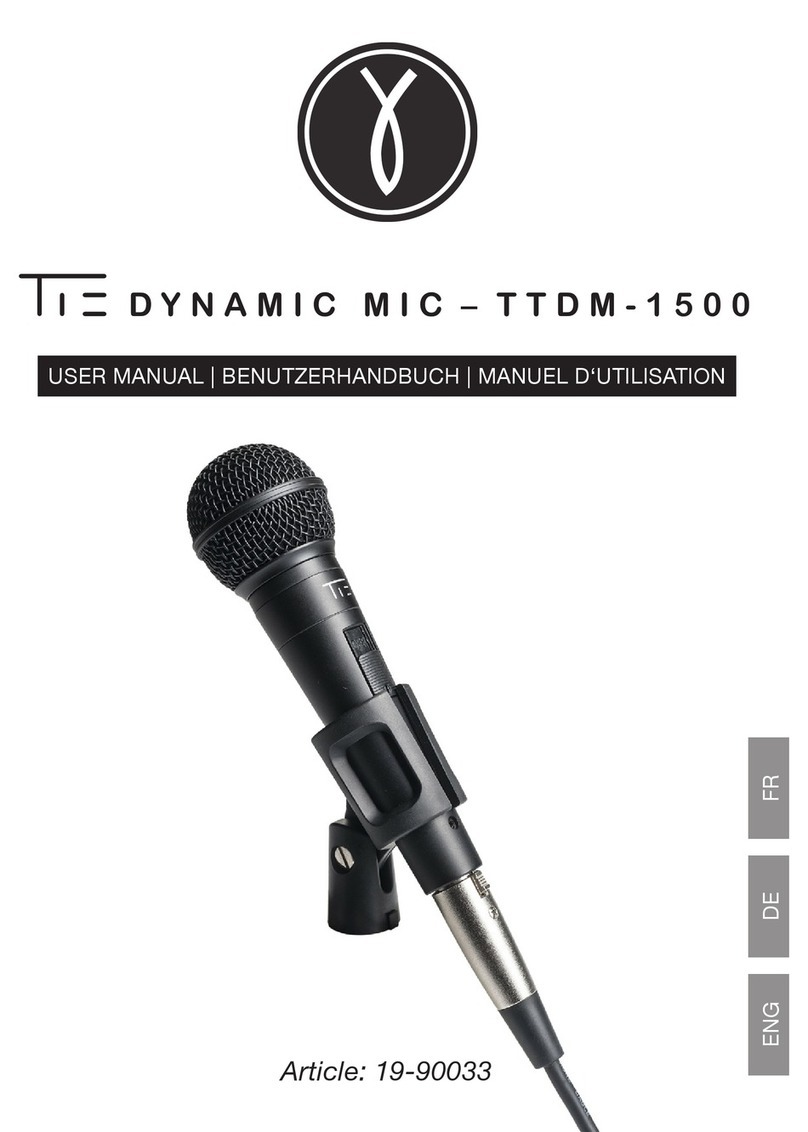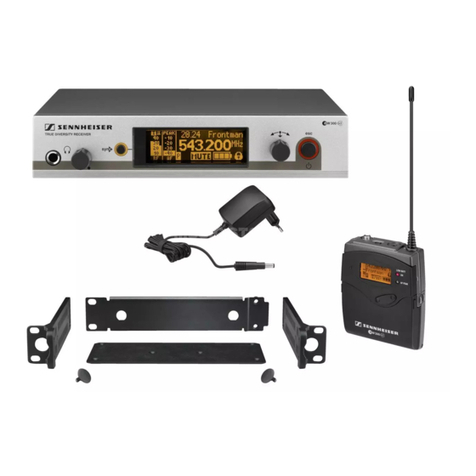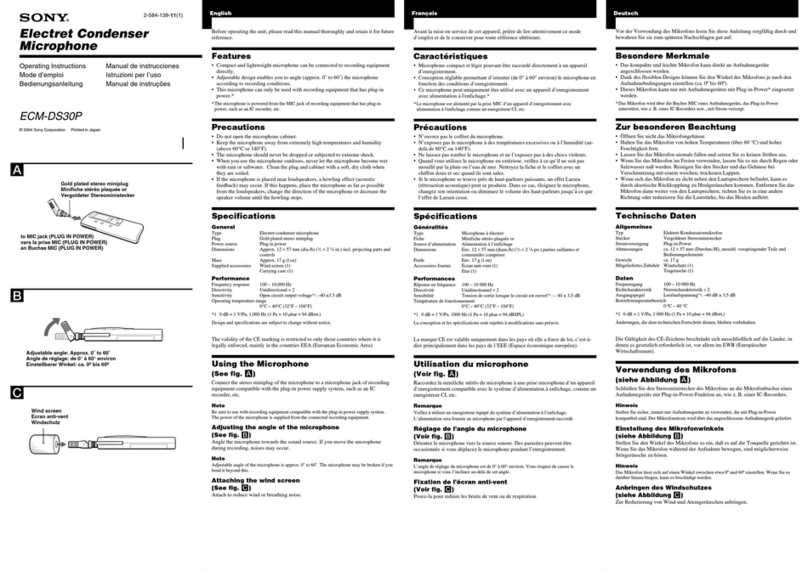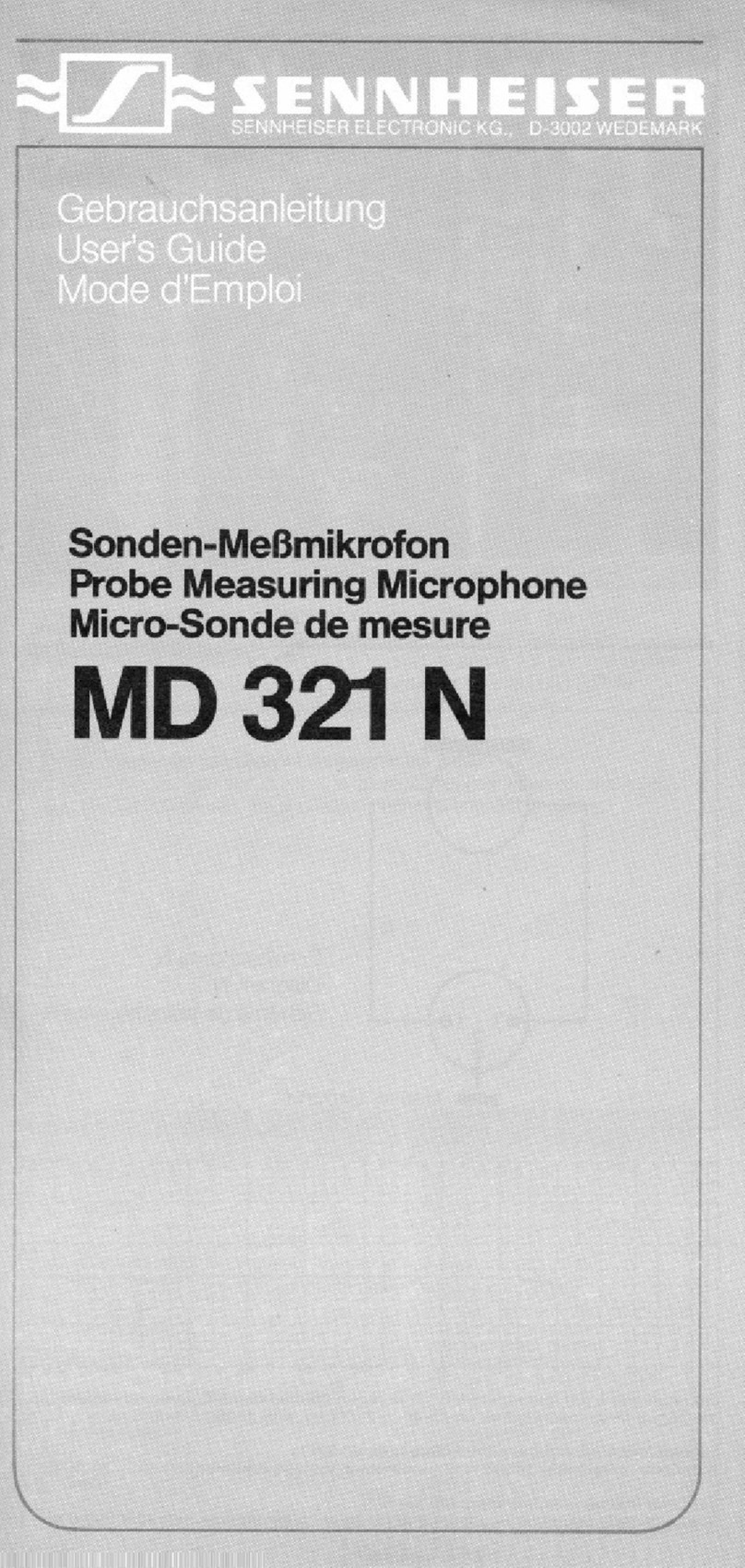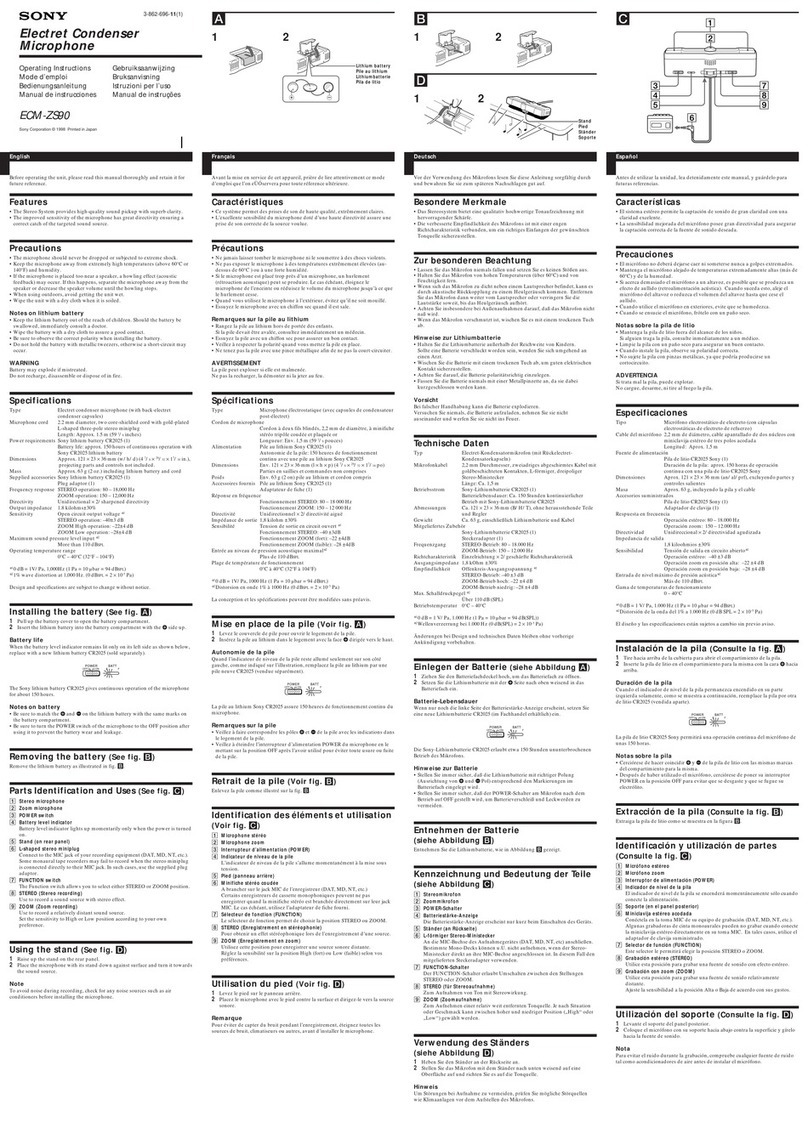Miktek T100 User manual

Introduction
ank you and congratulations on your purchase of the
Miktek T100 Snare/Tom/Instrument microphone. You
work hard to give a better than average performance,
so you demand a better than average microphone to
reproduce the sound of your drums. Miktek T Series
microphones offer way above average sound and build
quality, impressing the most discriminating engineers
and artists. Featuring cutting edge capsule designs that
are perfectly matched to Miktek’s proprietary output
transformers; the T Series microphones produce a
modern, yet truly classic sound, well suited to today’s
contemporary performers.
In the following sections of this manual you will find
a description of the T100’s features, step-by-step
set-up and operating instructions along with detailed
specifications. In addition, we’ve also included some
basic miking fundamentals for typical live sound and
recording applications. To some of us these may seem
very basic. However, at Miktek we want to encourage
young or new engineers to use our microphones, or at
least to read our manuals and learn something about
recording and live sound. We know you’re serious about
your sound because you purchased an outstanding
audio instrument, and at Miktek, we’re serious
about providing superior products and service to our
customers. We appreciate your patronage and hope
you enjoy using your microphone as much as we enjoy
making them.
Sincerely,
Michael Ketchell - Managing Director
T100 Features
• Dynamic Snare/Tom/ Instrument Microphone
• Neodymium Magnet
• Super Cardioid Pickup Pattern
• Custom Miktek Transformer
•Package with Lever Rim Mount Clip and Protective Case
Description
The Miktek T100 super cardioid, dynamic microphone
features a custom designed, neodymium capsule
element offering extremely clear and articulate sound
reproduction of conga, timbales, hand drum, high
and low toms, and of course, snare drum. The T100’s
frequency response is full and robust and is perfect for
reinforcing snare and toms in live sound applications.
T100
Dynamic Snare/Tom/Instrument Microphone
Owner’s Manual
The T100 features a carefully engineered capsule coupled
to a custom designed, boutique transformer, resulting
in a response that’s smooth and even with tight bass
along with articulate mids and highs. Plus, the capsule’s
unique labyrinth design provides the capsule’s unique
labyrinth design provides precise pattern control and
maximum gain and maximum gain before feedback, so
your snare and toms, cut through the PA with clarity and
distinction. The deep and honest response makes the
T100 snare/tom mic ideal for studio applications. With
high SPL capabilities the T100 can easily accommodate
the loudest drummers and can even be used to mic up
loud guitar amps. The T100’s steel grill and die cast body
ensure durability and reliability night after night. The
T100 can be set upon a traditional mic stand using the
included holder, or use the included LRM100 lever rim
mount clip to mount the T100 directly on a snare or tom.
The ultra stealth, dark gray finish make the T100 an
attractive complement to any drum kit. The Miktek T100
snare/tom microphone will reproduce the sound of your
drums faithfully, delivering a solid foundation to any live
or studio performance.
Understanding Polar Patterns
Perhaps the most important aspect of using your T100,
or any other microphone, is to understand its polar
pick up pattern. Every microphone has a characteristic
polar pattern that determines how well it accepts
or rejects signal coming from various areas around
the microphone capsule. There are many types and
variations of polar patterns but the three most common
are omnidirectional, bidirectional or figure-eight and
unidirectional or cardioid. Omnidirectional microphones
pick up sound from everywhere, producing the same
frequency response regardless of where the sound
source originates (in front of the mic, behind it, to the
side, etc.). A bidirectional or figure-eight microphone
picks up sound directly from the front and back while
rejecting the sound at the sides. In contrast, cardioid
mics are specifically designed to accept the sound coming
from directly in front, and to reject sound coming from
behind or from the sides. The T100’s capsule provides a
super cardioid polar pattern with an even tighter pick-
up pattern. While omni and bidirectional microphones
are very useful for a variety of applications, the majority
of miking situations in live sound applications require
unidirectional or cardioid microphones. When positioned
correctly, the cardioid pattern allows you to pick up more
of the sound you want and less of the sound you don’t
want. In live sound

T100 Specifications
Type ................ Dynamic
Polar Pattern: ........ Super
Cardioid
Frequency Response: .. 50Hz -
16KHz
Impedance: .......... 300 Ohms
Length: ............. 5.85 inches
Width: .............. 2.3 inches
Depth: .............. 2.3 inches
Net Weight: .......... 0.65 pounds
Specifications subject to change.
www.miktekaudio.com
situations, the polar pattern greatly determines how
prone a particular microphone is to inducing feedback.
Feedback is that nasty howling sound that occurs when
a mic is placed too close to a loudspeaker—the signal
from the loudspeaker is fed into the mic, then into the
loudspeaker, then into the mic, over and over. The super
cardioid pick-up pattern allows for better separation of
instruments on stage and more control over feedback in
live sound reinforcement.
Mounting the T100
The T100 can be mounted to any standard microphone
stand using the included mic stand holder. If you are
using a US standard 5/8-inch mic stand, remove the
Euro adapter by unscrewing it from the mic holder.
Loosen the thumb screw and slide the microphone into
the holder, then re-tighten the thumb screw. You can
attached the T100 to a standard drum rim using the
LRM100 lever rim mount clip. Push the lever down and
loosen the thumbscrew. With the lever down, tighten
the thumbscrew a bit to size to the rim, then push the
lever up. Take care not to overtighten. If necessary,
repeat the previous step.
Microphone Placement
To help maximize the quality of your performance,
you must pay careful attention to the placement of
your T100, and specifically, how it is positioned for
the instrument that you’re miking. As you become
more experienced in miking techniques, you’ll quickly
realize the microphone placement is critical to getting
the sound you want while maximizing gain before
feedback. When placing the mic around any instrument
or sound source, take notice of the position of the front
of house and monitor loudspeakers. In general, it’s
good practice to set the microphone behind the main
or front of house PA speakers to avoid feedback from
those speakers. Also, be conscious of nearby monitor
loudspeakers to avoid feedback on stage. When using
the T100 on snare or toms, the microphone can be
placed on top the drum, with the capsule pointed
straight on or at an angle with the drumhead. You can
place a second T100 under the tom for more sustain or
under the snare if you want to hear more of the snares.
When miking drums, it is good practice to position
the T100 so that it’s pointing at the area that’s at a
distance of about 1/3rd of the drum’s diameter from
the inside of the rim. From there the microphone can be
positioned to taste.
Setting Up the Signal Level
In order to get a good signal, first be sure that the
T100 is connected to a mixer or recorder input that is
microphone level. Most quality mixers, mic pre’s and
recorders provide microphone inputs with a mic trim
(“Trim” AKA Mic Gain or Level) control. The purpose
of the mic trim control is to set a good signal level and
minimize any noise associated with the mic inputs’
electronics. A good mic pre will also have a Clip or Peak
LED to show you when the input is at overload; the
level which distortion begins to occur. To set a good
clean level, set the T100 up in front of the desired
sound source and slowly turn up the mic trim until you
see the Clip LED light up. Then, turn the trim control
down until the LED does not light any more. On most
microphone inputs, the best setting is when the trim
control is turned up as high as possible without lighting
the PEAK LED.
The Proximity Effect
All cardioid or uni-directional microphones exhibit
a phenomenon known as “proximity effect”. The
proximity effect is the increase in low frequency
response a microphone exhibits as it is moved closer to
the sound source. Vocalists tend to love this effect since
when they get really close to the mic they get that “FM
radio”, big bass sound. Just as on a vocal, you can use
the proximity effect to adjust their tonal response of the
bass drum you’re miking. The key to developing the best
mic technique is experimentation, along with awareness
of the general principle that, the closer your T100 is
to a signal source, the greater the bass response. The
proximity effect’s bass lift is caused by the amount of
pressure present at the ports that are used to create the
directional pattern. Since omnidirectional microphones
do not have ports, they do not have proximity effect.
T100 Polar Pattern
Other Miktek Microphone manuals
